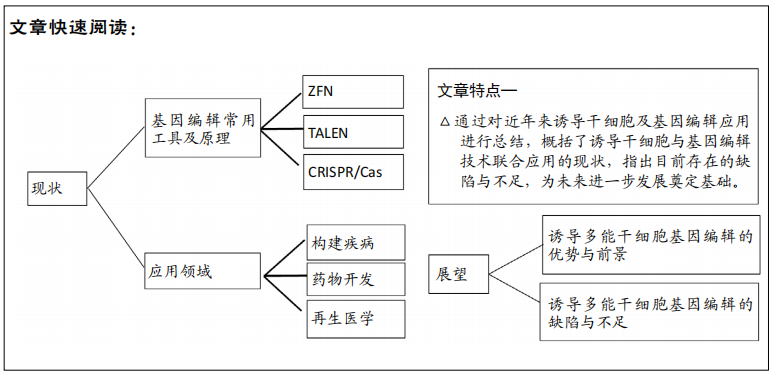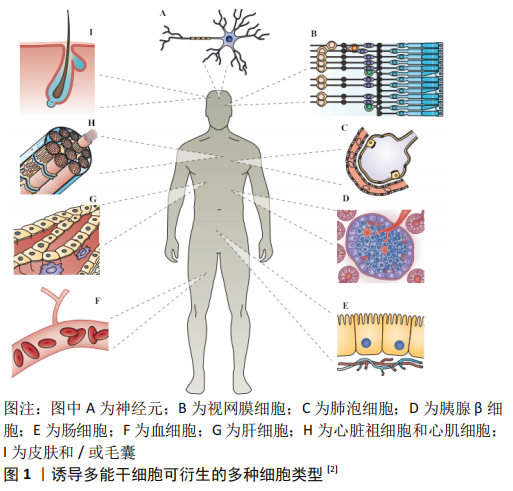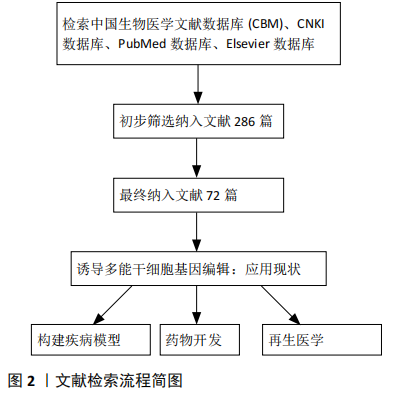[1] TAKAHASHI K, YAMANAKA S. Induction of pluripotent stem cells from mouse embryonic and adult fibroblast cultures by defined factors. Cell. 2006;126(4): 663-676.
[2] KIMBREL EA, LANZA R. Current status of pluripotent stem cells: moving the first therapies to the clinic. Nat Rev Drug Discov. 2015;14(10):681-692.
[3] STRECKFUSS-BÖMEKE K, WOLF F, AZIZIAN A, et al. Comparative study of human-induced pluripotent stem cells derived from bone marrow cells, hair keratinocytes, and skin fibroblasts. Eur Heart J. 2013;34(33):2618-2629.
[4] SI-TAYEB K, IDRISS S, CHAMPON B, et al. Urine-sample-derived human induced pluripotent stem cells as a model to study PCSK9-mediated autosomal dominant hypercholesterolemia. Dis Model Mech. 2016;9(1):81-90.
[5] SPITALIERI P, TALARICO RV, BOTTA A, et al. Generation of Human Induced Pluripotent Stem Cells from Extraembryonic Tissues of Fetuses Affected by Monogenic Diseases. Cell Reprogram. 2015;17(4):275-287.
[6] SPITALIERI P, TALARICO VR, MURDOCCA M, et al. Human induced pluripotent stem cells for monogenic disease modelling and therapy. World J Stem Cells. 2016;8(4):118-135.
[7] JODAT YA, KANG MG, KIAEE K, et al. Human-Derived Organ-on-a-Chip for Personalized Drug Development. Curr Pharm Des. 2018;24(45):5471-5486.
[8] EGLEN RM, REISINE T. Human iPS Cell-Derived Patient Tissues and 3D Cell Culture Part 1: Target Identification and Lead Optimization. SLAS Technol. 2019;24(1):3-17.
[9] YANG PC. Induced Pluripotent Stem Cell (iPSC)-Derived Exosomes for Precision Medicine in Heart Failure. Circ Res. 2018;122(5):661-663.
[10] DOUDNA JA, CHARPENTIER E. Genome editing. The new frontier of genome engineering with CRISPR-Cas9. Science. 2014;346(6213):1258096.
[11] GUPTA SK, SHUKLA P. Gene editing for cell engineering: trends and applications. Crit Rev Biotechnol. 2017;37(5):672-684.
[12] RAN FA, HSU PD, WRIGHT J, et al. Genome engineering using the CRISPR-Cas9 system. Nat Protoc. 2013;8(11):2281-2308.
[13] DELEIDI M, YU C. Genome editing in pluripotent stem cells: research and therapeutic applications. Biochem Biophys Res Commun. 2016;473(3): 665-674.
[14] JINEK M, CHYLINSKI K, FONFARA I, et al. A programmable dual-RNA-guided DNA endonuclease in adaptive bacterial immunity. Science. 2012; 337(6096):816-821.
[15] HODGES CA, CONLON RA. Delivering on the promise of gene editing for cystic fibrosis. Genes Dis. 2018;6(2):97-108.
[16] BITINAITE J, WAH DA, AGGARWAL AK, et al. FokI dimerization is required for DNA cleavage. Proc Natl Acad Sci U S A. 1998;95(18):10570-10575.
[17] WOLFE SA, NEKLUDOVA L, PABO CO. DNA recognition by Cys2His2 zinc finger proteins. Annu Rev Biophys Biomol Struct. 2000;29:183-212.
[18] LEE J, CHUNG JH, KIM HM, et al. Designed nucleases for targeted genome editing. Plant Biotechnol J. 2016;14(2):448-462.
[19] CUI X, JI D, FISHER DA, et al. Targeted integration in rat and mouse embryos with zinc-finger nucleases. Nat Biotechnol. 2011;29(1):64-67.
[20] CHANG CJ, BOUHASSIRA EE. Zinc-finger nuclease-mediated correction of α-thalassemia in iPS cells. Blood. 2012;120(19):3906-3914.
[21] SANDER JD, DAHLBORG EJ, GOODWIN MJ, et al. Selection-free zinc-finger-nuclease engineering by context-dependent assembly (CoDA). Nat Methods. 2011;8(1):67-69.
[22] BOGDANOVE AJ, SCHORNACK S, LAHAYE T. TAL effectors: finding plant genes for disease and defense. Curr Opin Plant Biol. 2010;13(4):394-401.
[23] MILLER JC, TAN S, QIAO G, et al. A TALE nuclease architecture for efficient genome editing. Nat Biotechnol. 2011;29(2):143-148.
[24] GUILINGER JP, PATTANAYAK V, REYON D, et al. Broad specificity profiling of TALENs results in engineered nucleases with improved DNA-cleavage specificity. Nat Methods. 2014;11(4):429-435.
[25] READ AC, RINALDI FC, HUTIN M, et al. Suppression of Xo1-Mediated Disease Resistance in Rice by a Truncated, Non-DNA-Binding TAL Effector of Xanthomonas oryzae. Front Plant Sci. 2016;7:1516.
[26] ZHU F, GAMBOA M, FARRUGGIO AP, et al. DICE, an efficient system for iterative genomic editing in human pluripotent stem cells. Nucleic Acids Res. 2014;42(5):e34.
[27] MAKAROVA KS, WOLF YI, IRANZO J, et al. Evolutionary classification of CRISPR-Cas systems: a burst of class 2 and derived variants. Nat Rev Microbiol. 2020;18(2):67-83.
[28] BARRANGOU R, FREMAUX C, DEVEAU H, et al. CRISPR provides acquired resistance against viruses in prokaryotes. Science. 2007;315(5819):1709-1712.
[29] HECKL D, KOWALCZYK MS, YUDOVICH D, et al. Generation of mouse models of myeloid malignancy with combinatorial genetic lesions using CRISPR-Cas9 genome editing. Nat Biotechnol. 2014;32(9):941-946.
[30] HISANO Y, SAKUMA T, NAKADE S, et al. Precise in-frame integration of exogenous DNA mediated by CRISPR/Cas9 system in zebrafish. Sci Rep. 2015;5:8841.
[31] KONDO S, UEDA R. Highly improved gene targeting by germline-specific Cas9 expression in Drosophila. Genetics. 2013;195(3):715-721.
[32] BELHAJ K, CHAPARRO-GARCIA A, KAMOUN S, et al. Plant genome editing made easy: targeted mutagenesis in model and crop plants using the CRISPR/Cas system. Plant Methods. 2013;9(1):39.
[33] MADSEN A, HÖPPNER G, KRAUSE J, et al. An Important Role for DNMT3A-Mediated DNA Methylation in Cardiomyocyte Metabolism and Contractility. Circulation. 2020;142(16):1562-1578.
[34] LYU C, SHEN J, WANG R, et al. Targeted genome engineering in human induced pluripotent stem cells from patients with hemophilia B using the CRISPR-Cas9 system. Stem Cell Res Ther. 2018;9(1):92.
[35] ZHANG HX, ZHANG Y, YIN H. Genome Editing with mRNA Encoding ZFN, TALEN, and Cas9. Mol Ther. 2019;27(4):735-746.
[36] JACKSON AL, LINSLEY PS. Recognizing and avoiding siRNA off-target effects for target identification and therapeutic application. Nat Rev Drug Discov. 2010;9(1):57-67.
[37] SEBASTIANO V, MAEDER ML, ANGSTMAN JF, et al. In situ genetic correction of the sickle cell anemia mutation in human induced pluripotent stem cells using engineered zinc finger nucleases. Stem Cells. 2011;29(11):1717-1726.
[38] FONG H, WANG C, KNOFERLE J, et al. Genetic correction of tauopathy phenotypes in neurons derived from human induced pluripotent stem cells. Stem Cell Reports. 2013;1(3):226-234.
[39] LI HL, FUJIMOTO N, SASAKAWA N, et al. Precise correction of the dystrophin gene in duchenne muscular dystrophy patient induced pluripotent stem cells by TALEN and CRISPR-Cas9. Stem Cell Reports. 2015;4(1):143-154.
[40] MAETZEL D, SARKAR S, WANG H, et al. Genetic and chemical correction of cholesterol accumulation and impaired autophagy in hepatic and neural cells derived from Niemann-Pick Type C patient-specific iPS cells. Stem Cell Reports. 2014;2(6):866-880.
[41] FRANK S, SKRYABIN BV, GREBER B. A modified TALEN-based system for robust generation of knock-out human pluripotent stem cell lines and disease models. BMC Genomics. 2013;14:773.
[42] MENON T, FIRTH AL, SCRIPTURE-ADAMS DD, et al. Lymphoid regeneration from gene-corrected SCID-X1 subject-derived iPSCs. Cell Stem Cell. 2015; 16(4):367-372.
[43] SUN N, ZHAO H. Seamless correction of the sickle cell disease mutation of the HBB gene in human induced pluripotent stem cells using TALENs. Biotechnol Bioeng. 2014;111(5):1048-1053.
[44] PARK CY, KIM J, KWEON J, et al. Targeted inversion and reversion of the blood coagulation factor 8 gene in human iPS cells using TALENs. Proc Natl Acad Sci U S A. 2014;111(25):9253-9258.
[45] PARK CY, KIM DH, SON JS, et al. Functional Correction of Large Factor VIII Gene Chromosomal Inversions in Hemophilia A Patient-Derived iPSCs Using CRISPR-Cas9. Cell Stem Cell. 2015;17(2):213-220.
[46] DEROSA BA, VAN BAAREN JM, DUBEY GK, et al. Derivation of autism spectrum disorder-specific induced pluripotent stem cells from peripheral blood mononuclear cells. Neurosci Lett. 2012;516(1):9-14.
[47] MOTAZEDIAN A, BRUVERIS FF, KUMAR SV, et al. Multipotent RAG1+ progenitors emerge directly from haemogenic endothelium in human pluripotent stem cell-derived haematopoietic organoids. Nat Cell Biol. 2020;22(1):60-73.
[48] ITZHAKI I, MAIZELS L, HUBER I, et al. Modelling the long QT syndrome with induced pluripotent stem cells. Nature. 2011;471(7337):225-229.
[49] KIM MJ, LEE EY, YOU YH, et al. Generation of iPSC-derived insulin-producing cells from patients with type 1 and type 2 diabetes compared with healthy control. Stem Cell Res. 2020;48:101958.
[50] RASHID ST, CORBINEAU S, HANNAN N, et al. Modeling inherited metabolic disorders of the liver using human induced pluripotent stem cells. J Clin Invest. 2010;120(9):3127-3136.
[51] LANCASTER MA, RENNER M, MARTIN CA, et al. Cerebral organoids model human brain development and microcephaly. Nature. 2013;501(7467):373-379.
[52] MARIANI J, COPPOLA G, ZHANG P, et al. FOXG1-Dependent Dysregulation of GABA/Glutamate Neuron Differentiation in Autism Spectrum Disorders. Cell. 2015;162(2):375-390.
[53] DEDHIA PH, BERTAUX-SKEIRIK N, Zavros Y, et al. Organoid Models of Human Gastrointestinal Development and Disease. Gastroenterology. 2016;150(5): 1098-1112.
[54] HOCKEMEYER D, JAENISCH R. Induced Pluripotent Stem Cells Meet Genome Editing. Cell Stem Cell. 2016;18(5):573-586.
[55] WANG L, YI F, FU L, et al. CRISPR/Cas9-mediated targeted gene correction in amyotrophic lateral sclerosis patient iPSCs. Protein Cell. 2017;8(5):365-378.
[56] LEE G, PAPAPETROU EP, KIM H, et al. Modelling pathogenesis and treatment of familial dysautonomia using patient-specific iPSCs. Nature. 2009;461 (7262):402-406.
[57] VINCENT F, LORIA P, PREGEL M, et al. Developing predictive assays: the phenotypic screening “rule of 3”. Sci Transl Med. 2015;7(293):293ps15.
[58] MATSA E, BURRIDGE PW, YU KH, et al. Transcriptome Profiling of Patient-Specific Human iPSC-Cardiomyocytes Predicts Individual Drug Safety and Efficacy Responses In Vitro. Cell Stem Cell. 2016;19(3):311-325.
[59] BURKHARDT MF, MARTINEZ FJ, WRIGHT S, et al. A cellular model for sporadic ALS using patient-derived induced pluripotent stem cells. Mol Cell Neurosci. 2013;56:355-364.
[60] YAMASHITA A, MORIOKA M, KISHI H, et al. Statin treatment rescues FGFR3 skeletal dysplasia phenotypes. Nature. 2014;513(7519):507-511.
[61] XU X, LEI Y, LUO J, et al. Prevention of β-amyloid induced toxicity in human iPS cell-derived neurons by inhibition of Cyclin-dependent kinases and associated cell cycle events. Stem Cell Res. 2013;10(2):213-227.
[62] WILLIAMS DP. Modeling hepatic drug metabolism and toxicity: where are we heading? Future Med Chem. 2014;6(7):725-727.
[63] TAKAYAMA K, INAMURA M, KAWABATA K, et al. Efficient generation of functional hepatocytes from human embryonic stem cells and induced pluripotent stem cells by HNF4alpha transduction. Mol Ther. 2012;20(1): 127-137.
[64] KAISER LR. The future of multihospital systems. Top Health Care Financ. 1992;18(4):32-45.
[65] MASON C, DUNNILL P. A brief definition of regenerative medicine. Regen Med. 2008;3(1):1-5.
[66] SIRISH P, THAI PN, LEE JH, et al. Suppression of inflammation and fibrosis using soluble epoxide hydrolase inhibitors enhances cardiac stem cell-based therapy. Stem Cells Transl Med. 2020 Aug 13. doi: 10.1002/sctm.20-0143.
[67] UÉDA K, FUKUSHIMA H, MASLIAH E, et al. Molecular cloning of cDNA encoding an unrecognized component of amyloid in Alzheimer disease. Proc Natl Acad Sci U S A. 1993;90(23):11282-11286.
[68] CHEN V, MONCALVO M, TRINGALI D, et al. The mechanistic role of alpha-synuclein in the nucleus: impaired nuclear function caused by familial Parkinson’s disease SNCA mutations. Hum Mol Genet. 2020;29(18):3107-3121.
[69] SII-FELICE K, NEGRE O, BRENDEL C, et al. Innovative Therapies for Hemoglobin Disorders. BioDrugs. 2020;34(5):625-647.
[70] DOULATOV S, VO LT, CHOU SS, et al. Induction of multipotential hematopoietic progenitors from human pluripotent stem cells via respecification of lineage-restricted precursors. Cell Stem Cell. 2013;13(4): 459-470.
[71] LUND RJ, NÄRVÄ E, LAHESMAA R. Genetic and epigenetic stability of human pluripotent stem cells. Nat Rev Genet. 2012;13(10):732-744.
[72] SEAH YF, EL FARRAN CA, WARRIER T, et al. Induced Pluripotency and Gene Editing in Disease Modelling: Perspectives and Challenges. Int J Mol Sci. 2015;16(12):28614-28634. |





